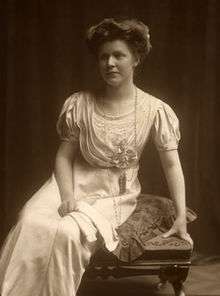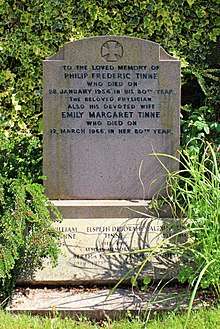Emily Tinne
Emily Margaret Tinne (née McCulloch; 21 August 1886 – 12 March 1966) was a British collector of clothes. Raised by a Presbyterian missionary to India, Tinne attended boarding school in England. She trained and worked as a teacher before marrying a wealthy doctor in 1910, at which point she started buying clothes from department stores in Bold Street, Liverpool, as well as having bespoke items made by a local dress maker. Her collection, which has been donated to the National Museums Liverpool, contains over 700 items and is the largest from an individual owned by a museum in the United Kingdom. The clothes are of high quality, with many items still unworn in their original tissue paper and boxes, the price tags and delivery information still attached.
Emily Tinne | |
|---|---|
 | |
| Born | Emily Margaret McCulloch 21 August 1886 Calcutta, India |
| Died | 12 March 1966 (aged 79) |
| Nationality | British |
| Known for | The Tinne Collection of Clothing |
Biography
Tinne was born Emily Margaret McCulloch on 21 August 1886 near Calcutta, India.[1] Her father, William McCulloch, was a Presbyterian missionary[2] and principal at a theological college in nearby Chinsurah, West Bengal.[1] Her mother was a stern lady, and the family's lack of means and Presbyterian beliefs made for a frugal upbringing.[2] Tinne had two brothers and a sister, and the four were sent to boarding school in 1893, when Tinne was about seven. During the school holidays, the children would live either with Tinne's maternal aunt in Sevenoaks, Kent or grandparents in Edinburgh. Her parents remained in India until the 1920s.[1]
Tinne studied as a domestic science teacher at Edinburgh School of Cookery, between 1904 and 1906, then moved to Aigburth, Liverpool to live with her maternal uncle, William Brogden Patterson.[1] There she found a teaching role at Liverpool Training School of Cookery & Technical College of Domestic Service, where she remained for three years until 1909.[1] During this period Tinne became engaged to Philip Frederick Tinne, a general practitioner whose family had a history as profitable sugar merchants and ship owners.[3][4] The couple married at the Welsh Presbyterian Church in Toxteth, Liverpool on 14 July 1910 and moved into a cottage in Aigburth.[5] They had six children, Elspeth, John, Bertha, Helen, Alexine and Philip, along with another who died in infancy,[6] and the growing family meant that they moved into a larger property in 1923 with an extension large enough for Philip's surgery at the rear of the house.[5]
Tinne's husband inherited £161,830 from his father in 1925, equivalent to about £6 million in 2006.[7] Tinne's sons were educated at Eton College, whilst her daughters went to local schools.[6] The family also had at least seven servants[6] and owned the first car in Liverpool.[8]
The Tinne collection of clothing
Mrs Tinne's Wardrobe: A Liverpool Lady's Clothes 1900–1940[2]
Tinne acquired a significant collection of clothes from shops in Bold Street, Liverpool shops and her local dressmaker.[9] The collection comprised both off-the-rail items and bespoke outfits.[10] She also made some clothes, including special outfits for her children's dance shows. The collection is held by National Museums Liverpool, donated in three stages by Emily Tinne's daughter, Alexine. Due to the sheer volume of items, Alexine would put out two tea chests per week, which would be collected by the museum.[8] The collection includes more than 700 items, though many other items could not be accepted due to the low quality.[11] The total collection included over 1000 items. The collection is the largest collection of an individual's clothing owned by a museum in the United Kingdom.[12]
The collection consists of items created between 1900 and 1940 and includes day and evening dresses, coats, underwear and stockings, swimwear, shoes, hats and gloves, baby and children's clothes, but is deficient in the shoes and handbags that would usually accompany a wearable ensemble. In addition, the collection includes Tinne's limited selection of jewellery, her servants' clothes and also some soft furnishings. To provide context, Tinne's collection of fashion magazines and sewing patterns are also included in the collection.[11]
Mrs Tinne's Wardrobe: A Liverpool Lady's Clothes 1900–1940[13]
Tinne bought multiple versions of the same item, often leaving them in the original tissue paper, with the original price labels and delivery dates.[14] Many of the higher value items were never worn, possibly because Tinne did not attend functions which would allow them to be due to her husband's evening surgeries.[8] Tinne's daughter, Alexine suggests that Emily may have purchased excess items or high value items that she did not want, to allow the shop assistants to gain commission.[14] This view is backed up by the curator of the exhibition, Pauline Rushton, who describes Tinne's social work in organising widows' pensions or helping unmarried mothers.[15] However, fashion author Linda Grant believes it was more likely that she just enjoyed shopping.[16]
The vast majority of the collection is dated between 1910 and 1940. Few items exist from before her marriage, when she started shopping "almost every afternoon",[13] nor from after the outbreak of World War II,[8] when she appears to have taken on a "make do and mend" attitude, which remained until her death.[2] The size of the collection caused strain between Emily and her husband, along with storage difficulties. The clothes were stored in tea chests and could be found in the couple's en-suite bathroom, the servants' quarters, and were even used to block off part of the cellar to secure other valuables.[14]

References
- Rushton (2006), p. 9.
- Rushton (2006), p. 28.
- Rushton (2006), p. 10.
- "Exhibition Gives a Fascinating Insight into the Family Life of Emily Tinne". Art Daily. Retrieved 13 March 2016.
- Rushton (2006), p. 13.
- Rushton (2006), p. 15.
- Rushton (2006), p. 14.
- Grant, Linda (2010). The Thoughtful Dresser: The Art of Adornment, the Pleasures of Shopping, and Why Clothes Matter (Reprint ed.). Simon and Schuster. pp. 51–52. ISBN 978-1-4391-5882-1. Retrieved 13 March 2016.
- Rushton (2006), p. 17.
- Knight, Lynn (2016). The Button Box: Lifting the Lid on Women's Lives. Random House. ISBN 978-1-4481-9153-6.
- Rushton (2006), p. 27.
- Grant, Linda (14 May 2008). "The woman who shopped for England". The Daily Telegraph. Retrieved 13 March 2016.
- Rushton (2006), p. 33.
- Rushton (2006), p. 34.
- Rajan, Amol (15 April 2009). "Move over Coleen Rooney, this was the first Wag". Independent. Retrieved 13 March 2016.
- Rawsthorn, Alice (21 March 2009). "Dressing the part". The Guardian. Retrieved 13 March 2016.
Sources
- Rushton, Pauline (2006). Mrs Tinne's Wardrobe: A Liverpool Lady's Clothes 1900–1940. Liverpool: The Bluecoat Press. ISBN 1-904438-20-2.